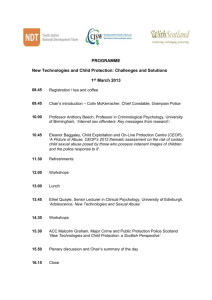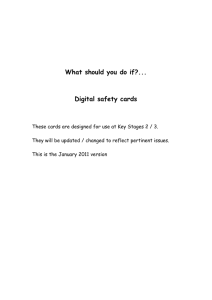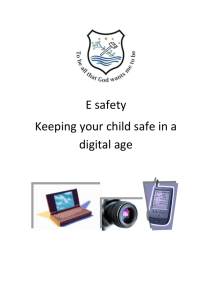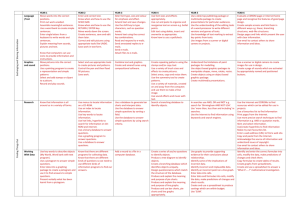NOTES FROM THE TWELFTH FORMAL CEOP TELECONFERENCE ON MODEL OUTPUT
advertisement
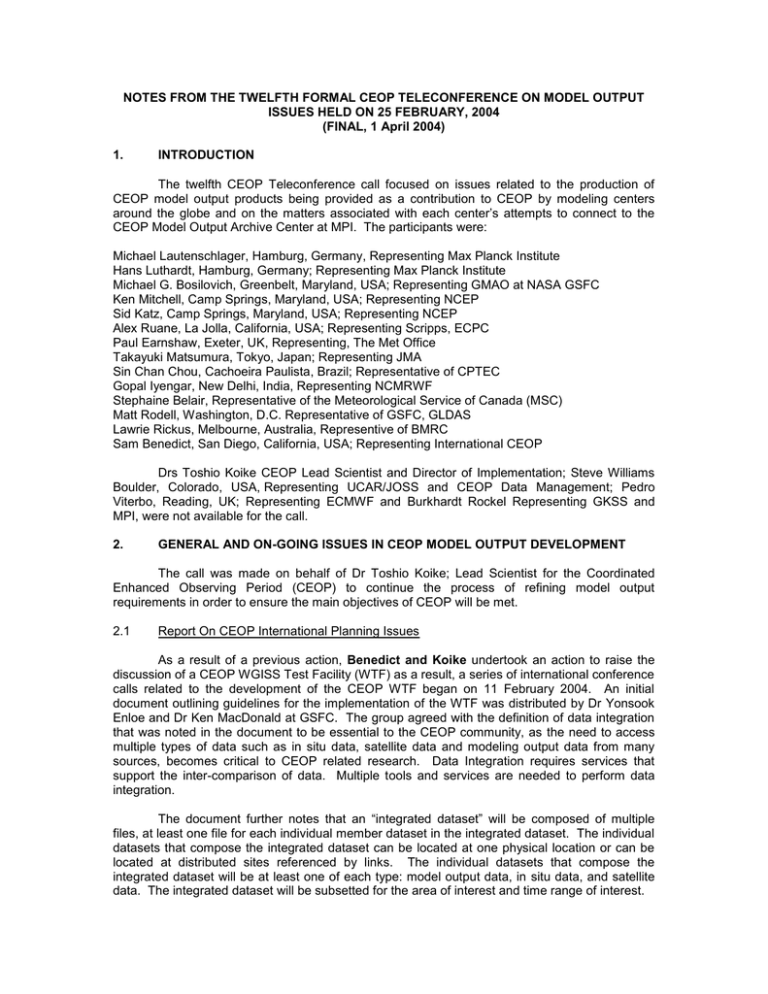
NOTES FROM THE TWELFTH FORMAL CEOP TELECONFERENCE ON MODEL OUTPUT ISSUES HELD ON 25 FEBRUARY, 2004 (FINAL, 1 April 2004) 1. INTRODUCTION The twelfth CEOP Teleconference call focused on issues related to the production of CEOP model output products being provided as a contribution to CEOP by modeling centers around the globe and on the matters associated with each center’s attempts to connect to the CEOP Model Output Archive Center at MPI. The participants were: Michael Lautenschlager, Hamburg, Germany, Representing Max Planck Institute Hans Luthardt, Hamburg, Germany; Representing Max Planck Institute Michael G. Bosilovich, Greenbelt, Maryland, USA; Representing GMAO at NASA GSFC Ken Mitchell, Camp Springs, Maryland, USA; Representing NCEP Sid Katz, Camp Springs, Maryland, USA; Representing NCEP Alex Ruane, La Jolla, California, USA; Representing Scripps, ECPC Paul Earnshaw, Exeter, UK, Representing, The Met Office Takayuki Matsumura, Tokyo, Japan; Representing JMA Sin Chan Chou, Cachoeira Paulista, Brazil; Representative of CPTEC Gopal Iyengar, New Delhi, India, Representing NCMRWF Stephaine Belair, Representative of the Meteorological Service of Canada (MSC) Matt Rodell, Washington, D.C. Representative of GSFC, GLDAS Lawrie Rickus, Melbourne, Australia, Representive of BMRC Sam Benedict, San Diego, California, USA; Representing International CEOP Drs Toshio Koike CEOP Lead Scientist and Director of Implementation; Steve Williams Boulder, Colorado, USA, Representing UCAR/JOSS and CEOP Data Management; Pedro Viterbo, Reading, UK; Representing ECMWF and Burkhardt Rockel Representing GKSS and MPI, were not available for the call. 2. GENERAL AND ON-GOING ISSUES IN CEOP MODEL OUTPUT DEVELOPMENT The call was made on behalf of Dr Toshio Koike; Lead Scientist for the Coordinated Enhanced Observing Period (CEOP) to continue the process of refining model output requirements in order to ensure the main objectives of CEOP will be met. 2.1 Report On CEOP International Planning Issues As a result of a previous action, Benedict and Koike undertook an action to raise the discussion of a CEOP WGISS Test Facility (WTF) as a result, a series of international conference calls related to the development of the CEOP WTF began on 11 February 2004. An initial document outlining guidelines for the implementation of the WTF was distributed by Dr Yonsook Enloe and Dr Ken MacDonald at GSFC. The group agreed with the definition of data integration that was noted in the document to be essential to the CEOP community, as the need to access multiple types of data such as in situ data, satellite data and modeling output data from many sources, becomes critical to CEOP related research. Data Integration requires services that support the inter-comparison of data. Multiple tools and services are needed to perform data integration. The document further notes that an “integrated dataset” will be composed of multiple files, at least one file for each individual member dataset in the integrated dataset. The individual datasets that compose the integrated dataset can be located at one physical location or can be located at distributed sites referenced by links. The individual datasets that compose the integrated dataset will be at least one of each type: model output data, in situ data, and satellite data. The integrated dataset will be subsetted for the area of interest and time range of interest. Following discussion of the document at the CEOP Meetings at Irvine, California, USA (812 March 2004) the document has been revised and will be re-distributed in due course for further comment and further revision. The “Model Output and Information” link at: http://www.joss.ucar.edu/ghp/ceopdm/model/model.html continues to be updated with new information. The site is also linked through the CEOP Data Management Web Page: http://www.joss.ucar.edu/ghp/ceopdm/, which also continues to be updated with new information about CEOP. Each CEOP Model Output Center Spokesperson (Viterbo, Mitchell/Katz, Chou, Rikus, Bosilovich, Rodell/Houser, Milton, Iyengar, Roads/Kanamitsu, and Matsumura) was reminded that as an on-going Action A1 they are asked to review the material at CEOP Model Output Web page noted above to ensure that it is current for their specific Center. As another on-going Action A1a, all of the participants (Viterbo, Mitchell/Katz, Chou, Rikus, Bosilovich, Rodell/Houser, Milton, Iyengar, Roads/Kanamitsu, and Matsumura) were asked to look at the CEOP Model Validation Studies Results Internet Page: http://monsoon.t.utokyo.ac.jp/ceop/model/telecon/. It is hoped that they will compare the results of the various activities that have been accomplished or which are still underway. The group confirmed that they or a representative of their Center would be at the CEOP Model Output and Analysis workshop at the University of California at Irvine (UCI) on 8-9 March 2004 in conjunction with the CEOP Third International Implementation Planning Meeting that will be held at the same venue from 10-12 March 2004. Viterbo noted that although he can not attend and no one else from ECMWF could be present at the meeting he would prepare a presentation and would be willing to participate in the meeting by way of a conference phone hook-up from his Office to the UCI meeting room. 2.2 Priority Topics in CEOP Model Output Development All of the participants in the call agreed that the priority activities necessary for the Model Output Component of CEOP to succeed are: (i) For all contributing centers to achieve routine transfer of data (push or pull) by electronic means (FTP) to/from MPI for placement in the CEOP Database, and (ii) For all contributing centers to access CEOP Model Output Database at MPI through their webpage at: http://www.mad.zmaw.de/CEOP or through the CEOP Data Management Page Model Output and Information section. A generalized/on-going action (A2) on each Center Spokesperson (Viterbo, Mitchell/Katz, Chou, Rikus, Bosilovich, Rodell/Houser, Milton, Iyengar, Roads/Kanamitsu, and Matsumura) is to continue to pursue the interactions with the Model and Data Group at Hamburg (Luthardt) on the two main issues identified above with the goal of establishing a routine connection between themselves and the data archive center at Hamburg for both the transfer of data and the accessing of the database. 3. PRIORITY ACTIONS AND RECOMMENDATIONS AND CENTER UPDATES In reference to the priority issues highlighted above, each Center provided an update of the work they have undertaken on behalf of the Model Output component of CEOP. 3.1 Sample Data Transfer Reports provided during the call made it clear that this work has been progressing well and data from at least five Centers (NCEP, JMA, UKMO, ECMWF, and ECPC) have been received and put into the database at the Hamburg facility, nearly completing this action for all the participants. Subsequently a new status was provided during the Meetings at Irvine and the Table below is the chart of the status of the receipt of data and placement in the CERA database that was provided at that time the actual status, however, is as of 27 February 2004. Luthardt accepted action A3 to keep this status chart as current as possible and to keep it available on the Model and Data Group CEOP Model Output Internet Page to reflect the latest contributions from all the Centers that have been received and passed an initial verification of content at MPI and that can, therefore, be made publicly available. The boxes that are not filled in on the chart represent data received at the database facility but not yet placed on the database itself. 3.2 CEOP Data Archive Administration Statement Because of the continued confusion about the nomenclature and lines of responsibility that are part of the CEOP Model Output effort in Hamburg it was felt that it was necessary to reiterate the clarifying statement issued during the last call and included in the notes of that call. It should now be clear to all the participants in the Model Output component of CEOP that The CEOP NWP Model Output Archive is part of the ICSU World Data Center for Climate that is housed at the German Climate Computing Center (DKRZ) at Hamburg, Germany. The Model and Data Group, a service provider for the German Climate Research Community, is in charge of handling, archiving and disseminating the data. This group is administered by the Max-Planck Institute for Meteorology (MPIM) at Hamburg and supervised by a national steering group, responsible for both the Model and Data Group and the Computing Center. 3.3 CERA Database Access Luthardt reported that the Internet link provided the Model and Data Group at: http://www.mad.zmaw.de/CEOP is still being adjusted to allow for the most reliable and easiest connections as possible. A joint action (A4) between the Model and Data Group at Hamburg (Luthardt: luthardt@dkrz.de) and all of the Center Representatives (Viterbo, Mitchell/Katz, Chou, Rikus, Bosilovich, Rodell/Houser, Milton, Iyengar, Roads/Kanamitsu, and Matsumura) will continue to be carried, which requires follow-through with efforts to connect to the MPI URL link and to verify that issues associated with the process of accessing data at the site are brought to light. In addition, action (A4a) must be maintained on an on-going basis for all Center Spokespersons (Viterbo, Mitchell/Katz, Chou, Rikus, Bosilovich, Rodell/Houser, Milton, Iyengar, Roads/Kanamitsu, and Matsumura) to move ahead with production of the required MOLTS and Gridded products and to immediately begin transferring complete months of data to MPI as soon as a reliable interface has been established 3.3 MOLTS Vertical Profile Data Format It was reaffirmed that all the Center Spokesperson (Viterbo, Mitchell/Katz, Chou, Rikus, Bosilovich, Rodell/Houser, Milton, Iyengar, Roads/Kanamitsu, and Matsumura) undertake to ensure the MOLTS data are archived at their local facility in whatever format they currently use. Subsequently at the CEOP Irvine Model Output Development and Analyses Workshop (8-9 March 2004) it was agreed that the work going on at ECMWF as reported by Viterbo during the Workshop should continue and should be the basis for any attempt by CEOP to “unify” the format of the MOLTS data being sent or being requested by users to/from the CERA database. In specific, Viterbo has agreed to undertake action A5, to follow through, as soon as possible, with the plan to provide: – A tool to convert ASCII MOLTS into netcdf is under preparation and will be offered for trial by interested groups The end result would then be a utility program that would be made available to the Model and Data group at Hamburg and to each Center to allow conversion of the MOLTS data to a standardized format. 3.4 Status at Contributing Centers (i) Rikus reported that BMRC was still readying the first 3 months of MOLTS output for transmission to MPI, but that this action and generation and transfer of gridded data were still being delayed by a minor processing issue. The first six weeks of data are being repackaged for transmission in the near future. Rickus is continuing to work on the validation of the data and the establishment procedures for CEOP production runs on a routine basis. (ii) Matsumura reported that JMA had produced MOLTS and GRIB data up to the end of CEOP EOP-3. These have been successfully sent to the CERA database. Work was progressing on subsequent months (1 October 2003 onward). Matsumura noted that JMA will be represented at the CEOP Model Output Development and Implementation Workshop at Irvine CA, from 8-9 March 2004 and that they would be prepared for more detailed discussions at that time. (iii) Alex Ruane reporting on behalf of Roads noted that ECPC successfully transferred six months of data starting with 1 July 2001. The data are being generated continuously from the start of EOP-1 and are being sent to the CEOP Database as they are completed and packaged for transfer. Ruane noted that as a new member of the ECPC team he would be attending the CEOP Model Output Development and Implementation Workshop at Irvine CA, from 8-9 March 2004. (iv) Bosilovich reported that he had an immediate proposal that had been funded that would extend work currently underway as well as provide the basis for new studies that would contribute to CEOP data and science related goals. A special application effort related to seabloom was one of the newer initiatives that may result in a new proposal and hopefully new funding. This work was being undertaken in concert with other groups at GSFC including the Earth Science Data and Information System (ESDIS) Project under the direction of Dr Ken McDonald. Bosilovich identified a potentially important tool for CEOP Model Data Output activities that he and others were going to begin exploring. The new capability has been identified at the Lambda optical network that has been funded by the NSF in the USA. The network is limited to only a short distance near Washington DC but there are plans to extend it to Scripps, GSFC and the University of Maryland. This would possibly allow extremely fast data transfers between these facilities and would provide evidence of a proof of concept that could give support to extending the network further and perhaps even internationally. Bosilovich agreed to provide more information on this at the CEOP Model Output Development and Implementation Workshop at Irvine CA, from 8-9 March 2004. (v) Mitchell and Katz reported that production of CEOP model output products at NCEP is continuing and that routine connections with MPI are being maintained. Mitchell reported that he felt confident in NCEP's CEOP model output strategy and that the progress NCEP had made toward the Model Output component of CEOP had been significant up to the current period. In addition NCEP's model validation and assessment against CEOP reference site data had been progressing in positive ways and the results were having an impact on the overall NCEP forecasting process. (vi) Earnshaw reported during the last call that the UK Met Office had demonstrated their ability to access the data at MPI and to successfully transfer data to the CERA database. However, the three months of data that had been entered on to the database and was shown to be in the system at the time of the last call had been recalled and taken off the database at the Met Office’s request. This explains the difference in the status in the status table above versus the one shown in the notes of the last meeting. The data had been found to have some inconsistencies, which require reprocessing. The CEOP data processing scheme at the Met Office has therefore been restarted. This issue will be discussed further at the time of the CEOP Model Output Development and Implementation Workshop at Irvine CA, from 8-9 March 2004. (vii) Viterbo reported in a written input, that All era40 fields should be available now on the MPI server. This was verified by the status table above. As noted earlier the era40 covers only up to August 2002, however, a rerun of more recent years is planned to start later this year, covering 1990-present, to be continued in near-real time. For the MOLTS, the list of variables has been defined and data for era40 to be produced in April, and delivered in ASCII, then data for operations will follow, with updates at the end of each month. As noted above, a tool to convert ASCII MOLTS into netcdf is under preparation and will be offered for trial by interested groups. The ECMWF data could be available on both formats (ASCII and netcdf). (viii) GLDAS was represented on the call by Rodell, who reiterated the work by GLDAS to produce products of importance to CEOP. The details of the long-term runs underway and planned had been provided in the notes of the last call. Basically, GLDAS undertook a LIS/Noah run at 1 degree resolution that covered the period 1January 2000 to present. Some adjustment are now underway, which when completed will lead to a 1/2 degree run from 1/1/1979 to 1/1/2000. It is planned that the resolution will then be set at a 1/4 degree from that point to the present. Status of the CEOP model products production process at GLDAS will be discussed at the CEOP Model Output Development and Analyses workshop at Irvine California, USA from 8-9 March 2004. (ix) Luthardt reported that work is continuing at MPI to accommodate the CEOP requirements. He noted that data transfers had been accomplished between MPI and seven of the contributing Centers. The formal status has been presented in the Table provided under Item 3.1 above. Details of the main issues under consideration by the CEOP Team at the Model and Data Group in Hamburg were highlighted during a joint meeting that was held in Hamburg over the period 20-22 January 2004. The main technical issues still facing the Model & Data Group at Hamburg were reiterated at the meeting to be related to defining a universal CEOP code table that represents a mapping of each NWP’s code numbers to the variables of the CEOP data set and developing standard formats particularly for the MOLTS data must be pursued to conclusion in due course. Other topics of further concern are related to more detailed Meta data for each dataset entered into the CERA database and finding sufficient resources for developing specialized product (level 2) datasets. (x) Iyengar reported that NCMRWF will provide the model output data for the EOP4 period 2003-2004 from the current operational version of the T80/L18 analysis-forecast system and that the interface between NCMRWF and MPIM has been activated. The analysis fields provided will be valid for 00, 06, 12 and 18UTC. These fields will contain only the 3D atmospheric variables on 15 pressure levels and Surface Pressure. The forecast fields provided will also be valid for 00, 06, 12 and 18UTC. The forecast fields will have the 2D surface fields in addition to the 3D fields. The details of the forecast fields were given in the notes from the previous call. The gridded data will be in the GRIB format that ECMWF uses (NCMRWF acknowledged the support of ECMWF in their provision of the GRIB software. The MOLTS data will be provided in ASCII format. (xi) Dr. Sin Chan Chou reported that an initial formal contact with Hamburg Model and Data Group is planned to take place soon, but that the initial transfer of data will need to wait until more information is obtained through face to face discussions, which are planned at the CEOP Model Output Development and Implementation Workshop at Irvine CA, from 8-9 March 2004. A more detailed plan for the CPTEC contribution to CEOP will be provided at the meeting and refined in time for the next CEOP Model Output Conference Call in April 2004. 4. NEXT CONFERENCE CALL ON CEOP MODEL OUTPUT ISSUES It was agreed at the time of the call that TUESDAY 27 APRIL 2004 would be the date of the next (thirteenth) conference call on CEOP Model Output issues. It is proposed that the call will take place at: 0830 at Washington DC, 0630 at Boulder, Colorado, 0930 at Cachoeira Paulista, Brazil, 1330 in the UK, 1430 at Hamburg, 2130 at Tokyo, 2230 at Melbourne and 1800 at New Delhi. Benedict has action (A6) to coordinate the origination of the call from the USA. This timeline represents a special challenge. If it is not acceptable for any one to participate in the call as noted it may be necessary to make other arrangements in the future.

